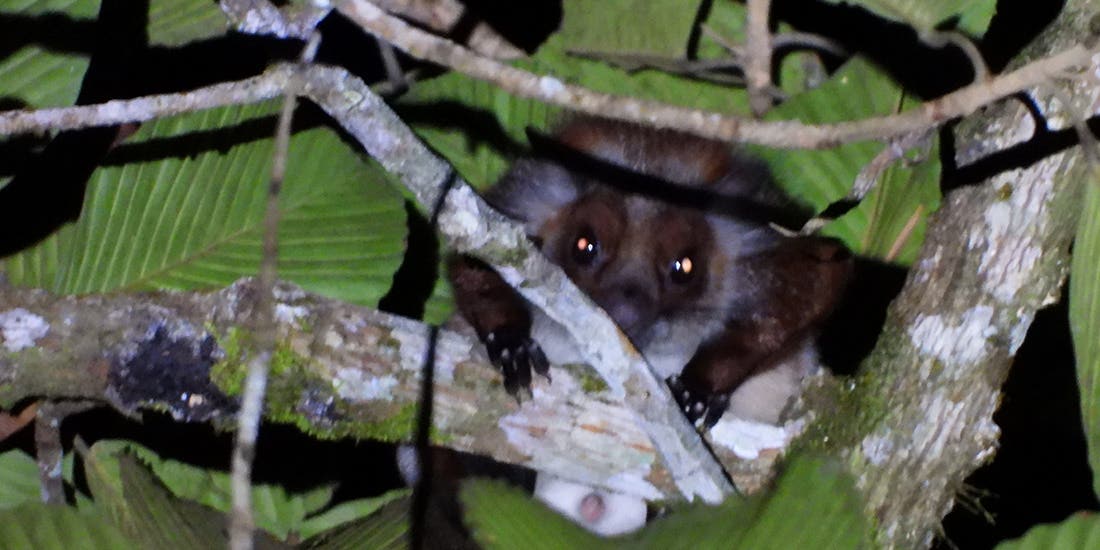There is usually very little about Re:wild’s Search for Lost Species that is simple. From defining what a lost species is, to obtaining the proper permits to do an expedition, to raising funds and then trekking through inhospitable landscapes to seek a needle in a haystack, every rediscovery feels a little bit like a miracle.
And then there are the challenges that are unique to each individual species. In the case of the search for the lost Namdapha Flying Squirrel, one of the world’s most wanted lost species, experts believe they are close — ever so close — to announcing the species’ rediscovery. But there’s a curveball in the shape of a furry doppelgänger: the Red Giant Flying Squirrel that looks a whole lot like our beloved Namdapha Flying Squirrel, but is a different species.
“Lost species rediscoveries rarely happen in a straightforward way, but usually wend and wind their way through a number of challenges before we can say with certainty that a lost species is no longer lost,” said Christina Biggs, Re:wild’s lost species officer. “The perseverance of our local partners, however, is a big part of what makes rediscoveries so sweet. We certainly hope this will be the case for the Namdapha Flying Squirrel, especially after all of the incredible work that our partners have already put in to find this species.”
Gliding toward a rediscovery
In partnership with Re:wild’s Search for Lost Species program, a research team from Aaranyak, one of India’s leading wildlife NGOs, has launched 10 expeditions for a total of 79 days to find the Namdapha Flying Squirrel. The flying squirrel’s last sighting was in India’s Namdapha National Park in 1981. The team — led by Dr. Firoz Ahmed — aimed to determine why the species hadn’t been seen over the past four decades and to establish if it is on the brink of extinction. The Aaranyak team includes Sourav Gupta, a field researcher and Sourav Mardi, a volunteer.
“As we pulled together a list of our most wanted lost small mammals, the Namdapha Flying Squirrel quickly rose to the top of that list,” says Dr. Ros Kennerley, co-chair of the IUCN SSC Small Mammal Specialist Group (SMSG). “It was described in 1981 based on a single individual and has been a mystery to science since then. We cannot prevent the extinction of a species unless we have even basic information about them, so finding this species and learning about it is a priority for us.”
The Aaranyak expedition team isn’t the first to look for the flying squirrel, which is likely to suffer from hunting and habitat destruction. Over the years, several other teams have set out in search of the species, but with no luck. During the first few months of the search, the Aaranyak team wanted to determine what type of habitat the squirrel most likely lives in to help inform their strategy for getting a photo of the evasive species.
After completing a comprehensive survey of the upper canopies in the forest, the team determined that the Namdapha Flying Squirrel is probably a riverine species, typically found close to the river.
“We realized that previous teams looked for this species in areas where they are actually unlikely to be found and where we were originally going to look,” Ahmed says. “So we redesigned our study to ensure that if the squirrel is still out there, we’d get a photo.”
The team then conducted a series of nightly visits to various potential sites. They split up into groups to look for the flying squirrel, shining their flashlights into trees to see if any tiny eyeballs returned the shine. The team started observing suspected Namdapha Flying Squirrels starting around March 2021, but could not get close enough to see or photograph in detail.
Finally, in April of 2022, the team reported a sighting that certainly looked like a Namdapha Flying Squirrel, which is one of 43 known flying squirrel species in the world. The Namdapha Flying Squirrel is the flying squirrel species with the highest extinction risk — Critically Endangered —according to the IUCN Red List of Threatened Species.
“We were over the moon when we first saw the photos that the field team managed to get of what we believe could be the species,” Kennerley says. “It was quite a feat to get this photographic evidence because not only is the species nocturnal, but it spends most of its time high up in the tree canopy.”
In the months since, however, experts have scrutinized and re-scrutinized the photos, looking for any telltale signs that this is the Namdapha Flying Squirrel rather than its cousin, the Red Giant Flying Squirrel, which is a similar size, similar in color, and also lives in Namdapha National Park. Previous potential sightings of the Namdapha Flying Squirrel have disappointedly turned out to be the Red Giant Flying Squirrel on cross examination by experts.
Cracking the case with DNA
“We are pretty sure that these photos are, in fact, the Namdapha Flying Squirrel,” Ahmed says. “But it’s not quite enough to say so conclusively. Our adventure continues and we hope we’ll be able to celebrate the rediscovery of the Namdapha Flying Squirrel soon.”
Since the photographs are not enough in this case to confirm the rediscovery of Namdapha Flying Squirrel, the expedition team has to turn to the next option: DNA.
“The next challenge will be to get some genetic samples to absolutely confirm this species has been found,” Kennerley says. “What we are trying to figure out now is how to get a sample like fur, scat or saliva from these flying squirrels. This will make setting up the camera traps seem quite easy in comparison.”
Ahmed and his team are currently working on designing a method to obtain DNA samples in the field. And if they are able to do that, they can compare that genetic material to the DNA of the individual collected in 1981 and that has since been stored in the Zoological Survey of India Museum in Kolkata, India.
“Flying squirrels are majestic animals and both species here make Namdapha National Park that much more special,” Ahmed says. “If we find the Namdapha Flying Squirrel, it will be a powerful flagship for conservation for both the park and other wildlife found here. And a great story to inspire hope for all of the other most wanted lost species.”
Special thanks to the Forest department Arunachal Pradesh for permits, the field director of Namdapha Tiger Reserve for providing local support, and team Aaranyak researcher Sourav Gupta and assistants Sourabh Mardi along with local guides, Erebo and Aphu for making this ongoing search possible.
Eddy Daniel is an environmental toxicologist and writer who is passionate about the environment and health. As an environmental writer, she writes to create awareness on environmental issues and tells stories of people and the work they do to protect the environment.




